 |
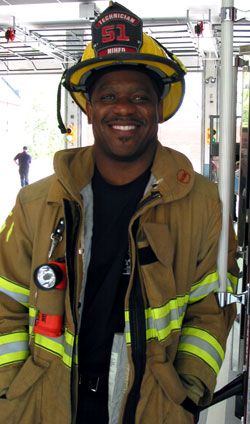
|
|
Darryl Lowery, Emergency Medical Technician, National Institutes of Health Fire Department, NIH, Bethesda, MD
|
1. I chose this career because...
2. My typical workday involves...
3. Specialized equipment I use on the job...
4. What I like best/least about my job...
5. My career goals are...
6. When I'm not working, I like to...
|
|
1. I chose this career because...
|
Back to Top

|
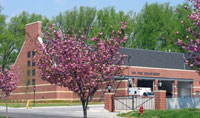
|
|
National Institutes of Health Fire Department, NIH, Bethesda, MD
|
I chose to become an emergency medical technician because of a great volunteer experience. When I was 16, I volunteered at the local fire department along with three of my best friends from high school. Early on, I took the necessary classes and became certified in cardiovascular pulmonary resuscitation (CPR), and advanced first aid. I continued working there while I finished high school. Many times I would go to the firehouse after school on Friday and stay there most of the weekend through Sunday. We had a lot of fun.
After high school, I began to take emergency medical services courses at the University of Maryland. In a few years, I completed 144 classroom hours and 20 hours of clinical training through the Maryland Fire and Rescue Institute (MFRI) program at College Park, Maryland. They are one of the largest fire and rescue training groups on the east coast. After completing the training, I sat for and passed the state certification test. It is necessary to recertify every 3 years, by taking a refresher course and another test.
To advance your medical career, you can complete increasing levels of training and certification. Each level requires completion of perquisite coursework and clinical training. In addition, individuals at each level must complete a certain number of hours of continuing education each year. In Maryland the increasing career levels include:
- Emergency Medical Technician Basic (EMT-B)
- Emergency Medical Technician Intermediate (EMT-I)
- Emergency Medical Technician Paramedic (EMT-P)
Education
Emergency Medical Technician basic and firefighter certification, Emergency Services Field Program, Maryland Fire and Rescue Institute (http://www.mfri.org/), University of Maryland, College Park, Maryland
|
|
2. My typical workday involves...
|
Back to Top

|
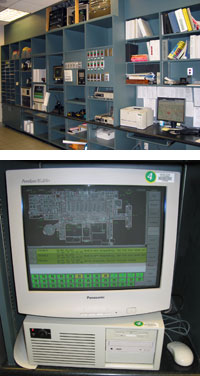
|
|
At the NIH firehouse, an entire wall in the dispatch room holds a variety of monitors and advanced technologies that aid EMTs in response to emergencies (above). A computerized fire alarm monitor helps locate fires in the main clinical center on campus (below).
|
My typical workday begins with roll call at 7:00 a.m. We get assignments and discuss our positions or roles for the day. For example, we decide who will be the driver of various vehicles. There are usually 2 people per ambulance or other emergency vehicle. We work a 72 hour work shift, that is, 24 hours on-duty, followed by 24 hours off-duty, and a final 24 hours on-duty, for a total of 72 hours per week. If understaffed, we may work more hours.
A Typical Workday Schedule
7:00 a.m.
- Answer roll call
- Receive assignments
- Inventory equipment and supplies
- Ensure equipment is functioning properly
- clean firehouse
8:30 a.m. – 9:00 a.m.
When necessary, we complete building inspections on campus. This includes routine inspections like testing fire alarms and fire extinguishers to ensure that we meet all fire safety codes.
7:00 a.m. – 3:00 p.m.
These hours are the core working hours, although we are responsible for responding to emergency calls at anytime.
3:00 p.m. to 7:00 p.m.
During these hours, we do station work that may include attending additional training courses. We often take courses here at the firehouse with our assistant chief who is a MFRI instructor. Many are 3 credit courses that can be used for college credit and towards a medical or health related degree. Most of our training is open to the adjoining fire departments. At various times, we invite community groups and students from area schools to teach them about safety and fire prevention.
7:00 p.m. to 7:00 a.m.
Throughout the evening, we remain on standby, waiting to respond to emergency calls.
Types of Calls
- Fire
- Hazardous materials – human exposure and spills
- All types of medical emergencies
We operate using a triage system, which is a method of prioritizing responses to life threatening and other types of emergencies as:
- Priority 1 – life threatening requiring immediate attention
- Priority 2 – requires medical attention but can be delayed
- Priority 3 - non-life threatening and requires medical attention as non-emergency
- Priority 4 – requires no medical attention or presumed deceased
Cooperating for Safety
We work from the NIH Fire Department building on the main NIH campus. As such, we are the primary responders for the NIH campus. However, we work cooperatively with other local firehouses like the Montgomery County Fire and Rescue Service and the National Naval Medical Center (NNMC). For example, we do helicopter standbys for the NNMC when soldiers are being transported to the medical center. The response may include transporting wounded soldiers or military staff to their assigned rooms in the medical facility. At times when we are understaffed, volunteers and employees from neighboring firehouses standby to answer our emergency calls.
|
|
3. Specialized equipment I use on the job...
|
Back to Top

|
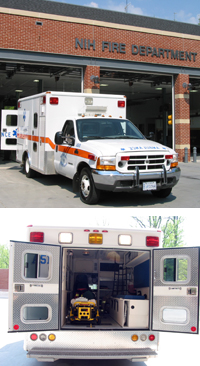
|
|
An ambulance emerges from one of three bays at the NIH Firehouse (above). From the rear of the ambulance, EMT’s access supplies to treat patients with medical emergencies while en route to a full medical care facility (below).
|
We rely on specialized equipment and technology to complete our daily tasks.
Emergency Vehicles/Units
- Ambulance – vehicle used in response to medical emergencies
- Fire truck – vehicle used in response to fire emergencies
- Decontamination unit – unit used to decontaminate people who are exposed to radiation or harmful chemicals
- Bomb trailer – unit used to detonate bombs
Technology and Computer Software Programs
- Fire alarm monitor – system that monitors fire and emergency alarms for a particular building
- Keltron monitor – monitors fire and emergency alarms by geographical region
- GPS locator – system that locates emergency vehicles, which are displayed on a monitor in the dispatch office, and helps route drivers to the appropriate site.
- Weather monitor – system that uses a meteorology software program to interpret weather patterns and related information via a satellite
|
|
4. What I like best/least about my job...
|
Back to Top

|
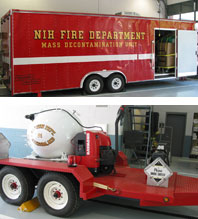
|
|
A decontamination unit (above) and a bomb trailer (below) help the specially trained staff respond to emergencies involving hazardous materials.
|
What I like best about my work is the group of guys I work with. Everyday is a different page in a book.
What I like least about my work is that sometimes people request emergency services when the situation in not an emergency. For every emergency call, we have detailed instructions that we must follow. If it is not really an emergency, then it can be very costly and time consuming, limiting our availability for true emergencies.
|
|
5. My career goals are...
|
Back to Top

|
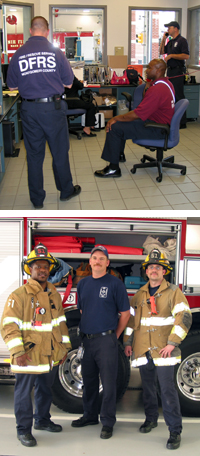
|
|
EMTs and paramedics from surrounding communities man the dispatch room while NIH first responders are out on calls (above). Darryl Lowery, James Rice and John Bede (below - left to right).
|
My career goal is to get my bachelors degree in fire science. As you get older, it is physically harder to go out on some of the emergency calls. So I am looking ahead to retirement and considering other opportunities. At age 57 you have to retire as a federal firefighter.
|
|
6. When I'm not working, I like to...
|
Back to Top

|
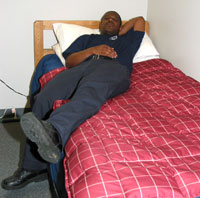
|
|
| |
Darryl Lowery enjoys a rest in one of the firehouse bunk-rooms after working a long shift.
|
When I’m not working, I like to sit-back and relax, or go riding in my car. With long working hours and sometimes being up all night, you look forward to the chance to catch up on your rest.
|
|
|
|
 |